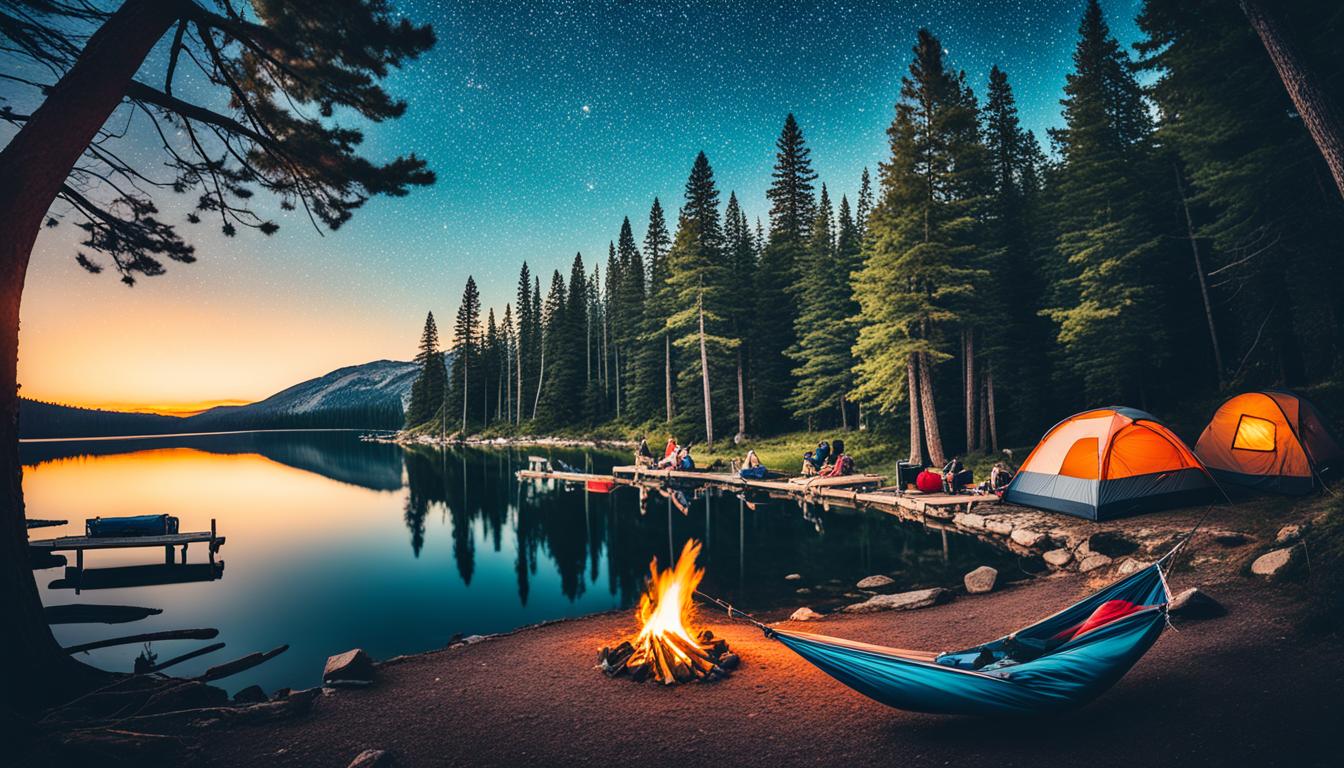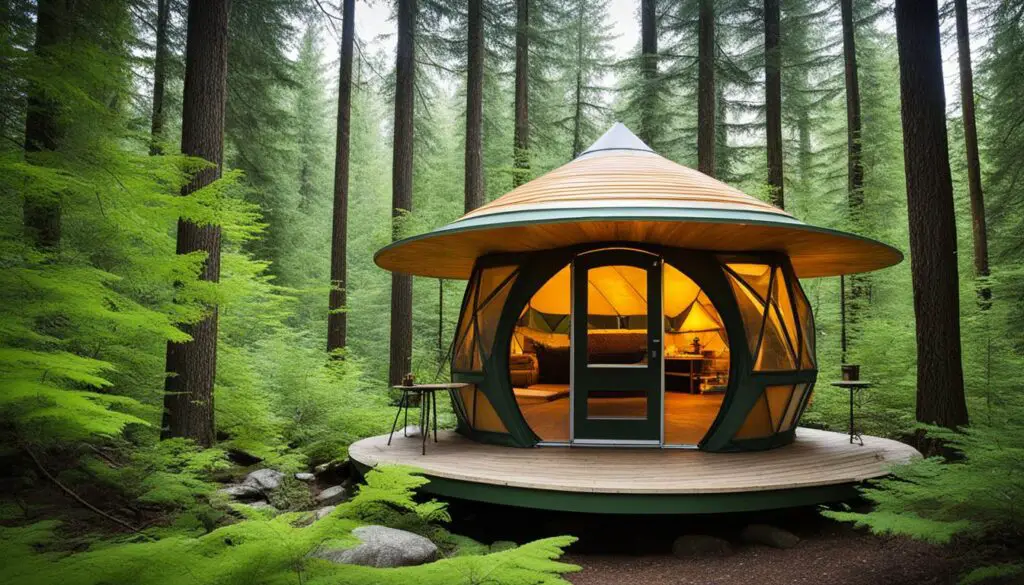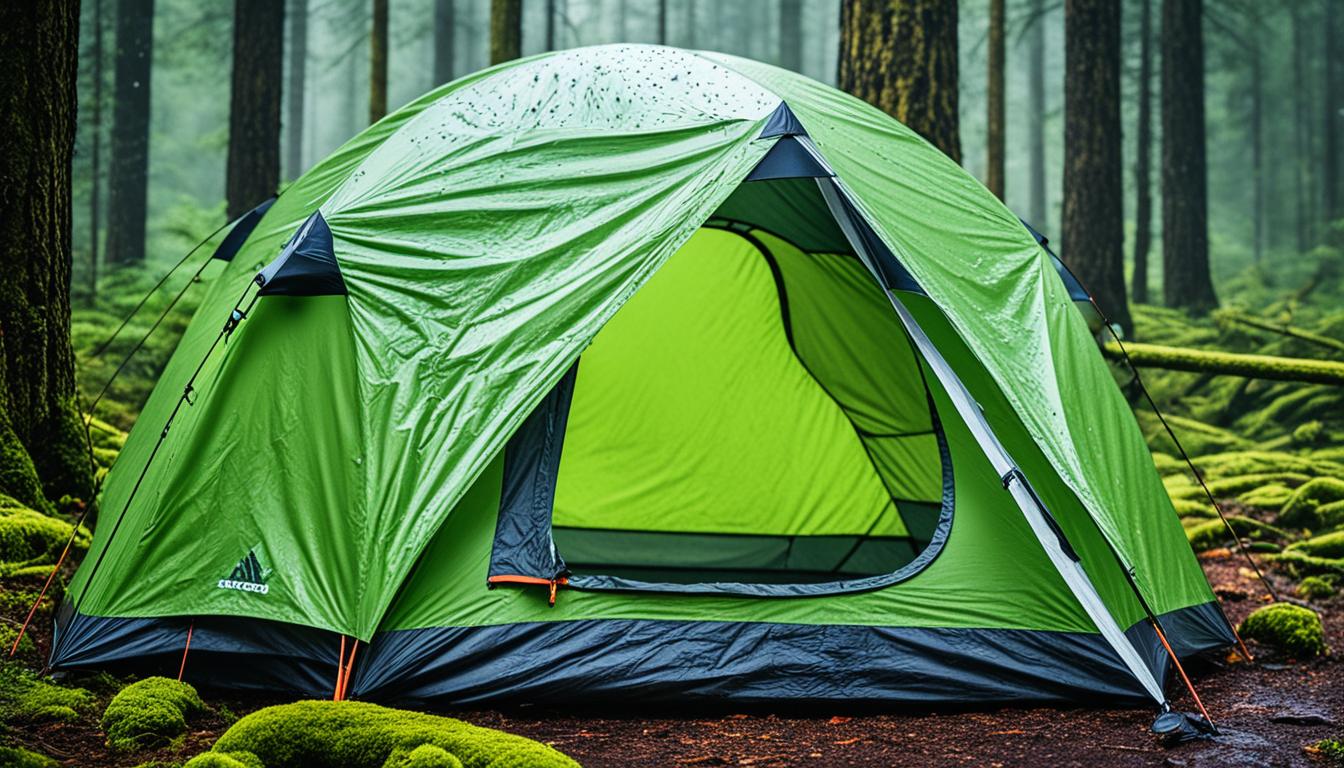
In this guide, we’ll look at new ways to camp without traditional tents. You can enjoy the comfort of hammocks or the ease of camping pods. This article shares unique alternatives for your outdoor trips. Whether you prefer a simple style or want something different, we have ideas to fit your needs.
Tents are still very popular for camping in the U.S. Yet, people are now choosing from a wider selection of camping options. These new choices are meeting the needs of campers who want something light and versatile.
Camping is changing with the times. More campgrounds now offer RV hookups and Glamping Tents at KOA spots. Also, more people are renting Airstream trailers for their trips. This offers a different kind of comfort while camping.
Let’s explore unique ways to camp that don’t involve traditional tents. From something simple to luxury options, we have you covered. Backpackers, families looking for a cozy time, or adventurers up for a challenge will find great ideas here.
Exploring Unconventional Camping Solutions
Today, many outdoor lovers are turning to minimalist camping gear and lightweight camping equipment. This move simplifies camping and deepens our bond with nature.
Embracing Minimalism: The Art of Lightweight Camping
Long gone are the days of heavy, large tents and gear. A new breed of adventurers prefers camping without traditional tents. They choose lightweight, easy-to-use tools like compact hammocks and versatile tarps. These minimalist camping gear options bring a new light to the camping scene.
Reconnecting with Nature: The Benefits of Camping Alternatives
Choosing alternative camping solutions lets you connect deeply with nature. Without the limits of big tents, the perks of alternative camping shine. You can really soak in the outdoors, leading to increased mindfulness and lower stress. Plus, you’ll grow to love the wilderness even more.
No matter if you camp a lot or are just starting, trying unconventional camping solutions is eye-opening. By getting into lightweight camping and camping without traditional tents, you’re in for a trip that highlights the beauty of simplicity and nature’s healing.
Hammocks: A Swinging Good Time
Have you ever thought about trying a hammock for camping? It’s not just any old thing. It lets you sleep while rocking gently. This way, you really feel part of nature in a whole new light.
There are a lot of good things about sleeping in a hammock. To start, hammocks are light and easy to carry. Instead of hunting for a flat spot to pitch a tent, you just need two trees. Then, you’re up high and comfy for the night.
Plus, hammocks are super comfy and flexible. They fit the shape of your body like a gentle hug. This means you can sleep well, even if the ground is lumpy. The breeze also flows freely around you, so you stay cool.
Thinking about trying out a hammock? Here’s what to remember. Pick one that’s tough and meant for the outdoors. It should be able to stand up to weather and have strong hooks. Also, be careful where you hang it. Make sure the trees or poles are safe and sturdy.
There are so many cool hammock options out there. You’ve got hanging tents and all kinds of gear made just for hammock campers. Getting into hammock camping can make your trips more comfy and fun. You really get to enjoy the outdoors in style.
If you love camping, hammocks are a game-changer. They offer a new way to enjoy the wild without giving up on comfort. So, it’s time to swap your tent for a hammock. Get yours and start swinging your way to awesome adventures under the stars!
Camping Alternatives to Tents: Unique Shelters
Hammocks give a different and cozy way to sleep outdoors. Beyond the usual tent, there are many cool camping shelters. We’ll look into tarps and bivvies. They are light, flexible, and bring unique advantages to your trips.
Tarps and Bivvies: Flexible and Lightweight Options
Tarps and bivvies make great choices other than tents. Tarps are big, waterproof sheets you can set up in many ways. They keep you dry and save space in your pack. Bivvy bags are like waterproof, breathable sleeping bag covers. They’re great for one person or a simple setup.
Tarps and bivvies can be used on their own. You can make a simple shelter with a tarp. Or, get creative and add things like poles or trees for bigger setups. Bivvy bags go well with sleeping pads or tents. They add an extra layer of protection.
One big plus of these alternative camping shelters is how light they are. They weigh less than regular tents. This is great for backpacking, biking, or when saving space is key. Every ounce saved matters on long hikes or biking trips.
The simple designs of tarps and bivvies also help you connect with nature. Using them may make you learn more about your environment. It can make every camping trip more meaningful as you work with nature.

Love backpacking, outdoor life, or just a bit of adventure? Tarps and bivvies might be for you. They offer a new way to enjoy the outdoors without a traditional tent. Try tarp camping and bivvy bag camping for a fresh experience. You’ll have amazing adventures under the open sky.
Camping Pods: Comfort Meets Convenience
Camping pods are perfect for those who want comfort and convenience in nature. They are like cabins but let you feel connected to the outdoors. They offer a cozy space with the freedom of camping.
Exploring the World of Camping Pods
Known as glamping pods, they are insulated and self-contained. These structures are a step up from traditional tents. They vary in size and come with heating, lighting, and cooking areas.
Camping pods can be in various places, from campgrounds to remote areas. This means you can enjoy nature with some modern comforts. They’re good for both relaxing escapes and adventures with family.
Pros and Cons of Camping Pods
Camping pods offer a luxurious shelter that’s also weather-resistant. They come with extra features like furniture and power sockets. This makes your camping experience better.
Yet, their luxury and comfort mean they’re more costly than tents. Prices change with the pod’s size, type, and where it’s located. Also, using a pod might not feel as free as camping without one. They’re often in specific areas or resorts.
| Pros of Camping Pods | Cons of Camping Pods |
|---|---|
|
|
Deciding on a camping pod depends on what you want from a camping trip. It’s important to consider the cost, your preferences, and the experience. This way, you can choose what’s best for you and your camping goals.
Rooftop Tents: The Ultimate Adventure Vehicle
For those who love adventure, rooftop tents are a game-changer. They turn your car into a mobile campsite. This lets you camp in new and exciting places.
Rooftop tents keep you up high for safety and a great view. They make it easy to enjoy the beauty around you. A rooftop tent is perfect for both off-the-beaten-path trips and for cozily camping in popular spots.
Choosing the right rooftop tent is important. You should think about your vehicle’s size and how heavy a tent it can hold. Also, think about how easy it is to put up and how strong it is against wind and rain. Look for extra things like comfy mattresses, places to store stuff, and ways to keep air flowing inside.
| Rooftop Tent Advantages | Considerations for Choosing a Rooftop Tent |
|---|---|
|
|
If you love the outdoors, rooftop tents are for you. They offer a fun way to camp. Pick the best tent for your kind of adventure to make the most of your trip.
Leave No Trace: Sustainable Camping Practices
We love the outdoors. And it’s up to us to keep nature safe. No matter how you camp, using eco-friendly ways is key. This helps lower your impact on nature when you adventure. We’ll check out the Leave No Trace rules and tips to be a greener camper.
Minimizing Your Environmental Impact
Leave No Trace (LNT) gives a guide for fun outdoor times without harm. It helps save nature’s beauty wherever you go. Let’s look at a few LNT rules for your camping trips:
- Plan Ahead and Prepare: Look up your spot, bring just what you need, and know the camping rules. This makes sure you camp in a friendly way.
- Travel and Camp on Durable Surfaces: Stay on marked trails and in legal campsites to not hurt plants. Also, keep off the grass to protect it.
- Dispose of Waste Properly: Take all trash away, even food and bathroom stuff. Keep the area clean using good hygiene habits.
- Leave What You Find: Don’t take or break nature and old things. See and enjoy nature without changing it.
- Minimize Campfire Impacts: Cook with a small stove if you can. Only have fires where it’s okay. Put out fires all the way before you go.
- Respect Wildlife: Watch animals away from you. Don’t feed them. Keep your food safe from them to avoid trouble.
- Be Considerate of Other Visitors: Be quiet and nice. Leave the place like new for others.
These sustainable camping ways let you love nature without harming it. Camp lightly to keep Earth pretty for all. Respect for Earth camping isn’t just nice; it’s our duty as nature’s friends.
Camping Alternatives to Tents: A Roundup
In this article, we looked at different ways to camp without a traditional tent. We talked about hammocks and camping pods. Each option has its own good points. Now, we’ll sum up how these choices compare to each other.
Hammocks give you a light and close-to-nature feeling. This makes them great for those who like to keep things simple. Tarps and bivvies, however, are better for those who want to explore a lot. They’re light and can be set up quickly.
Camping pods are a luxury choice for campers who don’t mind staying put. They come with beds and sometimes even electricity. Yet, they’re not as flexible as the other options we talked about.
FAQ
What are some camping alternatives to traditional tents?
There are many alternatives to traditional tents, like hammocks and tarps. Bivvies, camping pods, and rooftop tents are great too. They are portable and offer more comfort and convenience.
What are the advantages of hammock camping?
Hammock camping is both comfortable and versatile. It lets you sleep above the ground, which is unique. Hammocks are light, easy to set up, and connect you with nature.
How do tarps and bivvies compare to traditional tents?
Tarps and bivvies are lighter and more flexible than traditional tents. They follow a minimalist approach, providing essential shelter. They’re great for those who like to backpack light and venture into the wild.
What are camping pods, and what are the pros and cons of using them?
Camping pods are ready-to-use shelters offering a more comfortable camping option. They provide better weather protection and a glamping experience. However, they could cost more and limit your camping spots.
How do rooftop tents enhance the camping experience?
Rooftop tents are perfect for overlanding and mobile camping. They offer a cozy, high-up sleeping spot. This makes camping more comfortable, especially in remote areas.
What are the principles of Leave No Trace, and how can I apply them to my camping adventures?
The Leave No Trace principles are about eco-friendly camping. They include planning well, cleaning up trash, and being careful with fire. Also, you must respect animals and keep places clean. Following these rules protects the environment.
- Discover the 4 Must-Have Camping Tent Accessories for Spring 2025 - March 19, 2025
- Why Camping Is Bad - November 29, 2024
- Best Camping Knife - November 29, 2024






